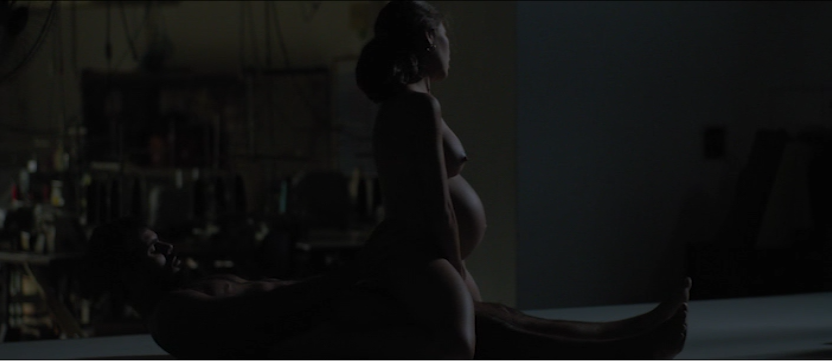Reframing Humans, Animals and Land in Contemporary Brazilian and Argentinian Cinema, Essay 4: The Transgressive Power of the Erotic in Boi Neon (2015)
May 14, 2019
Dana Khromov
The following post is an essay by Dana Khromov, PhD Candidate in Hispanic Studies at the University of Pennsylvania. It is the fourth essay in the 5-part series "Reframing Humans, Animals and Land in Contemporary Brazilian and Argentinian Cinema". In it, Dana looks at how Gabriel Mascaro's 2015 film Boi Neon employs the erotic to challenge the separation of labor time from leisure and private space from public.
The Transgressive Power of the Erotic in Boi Neon

The erotic is perhaps the most intriguing and certainly the most exciting point of entry into Gabriel Mascaro’s Boi Neon (2015), a film whose patient accompaniment of a group of itinerant ranch hands in their everyday activities foregrounds the textures, tensions and desires of human and animal bodies from beginning to end. With no clear narrative arc and little dialogue, the film strings together a series of episodes that feature the grooming and care of both human and animal bodies involved in vaquejada, a traditional Northeastern Brazilian sport in which two cowboys knock a bull over by its tail. Spectators watch the truck driver Galega wax her crotch with masking tape in the front seat of her truck; Iremar, the ranch hand who dreams of becoming a fashion designer, bathe with a group of other vaqueros; Junior, a newcomer, alternately floss his braces and straighten his hair; and all three, along with Galega’s preadolescent daughter Cacá brand a bull.
Though there are only two actual sex scenes, the film gradually builds sexual tension that is not limited to a particular couple nor serves any dramatic purpose, instead coloring interactions in general among the ranch hands, Cacá and the horses and bulls they work with. At times it’s subtle: Galega flirting with a street seller who offers her three-for-one panties and assures her, “the tighter the better”, or Cacá hugging Junior not without a hint of sexual intrigue. At others more explicit, like when Iremar and his fellow ranch hand Zé masturbate a horse for his exceptionally potent semen. But no matter the degree, the erotic runs as an undercurrent through the film, released from its containment to private spaces and leisure time, and from its reproductive function. It is reserved neither only for adults nor only for humans, but filters through all interactions, becoming a way of relating rather than a means to an end.
This ubiquitous eroticism sets the stage for what I see as two of the film’s most salient interventions: the suggestion of desire rather than power as the basis for the human relationship to animals, and a decentering of labor through a transgression of taboo that challenges capitalism’s spatial and temporal separation of work from leisure.
The constant proximity and contact between humans, horses and cattle throughout the film sets the stage for an oneiric scene in which an unidentified vaquero moves through a series of positions with a horse that rewrites their relationship from one of domination to one of intimacy and desire. They begin in the mounted position which connotes domination and exploitation and end up with the vaquero stroking the horse’s torso as she faces the camera with her belly up and legs splayed, in an indisputably erotic interaction.
The constant, suggestive presence of the erotic described above arouses (dare I say) the spectator in a slow crescendo so that the seven minutes of sex in the penultimate scene feels like a natural climax. On the heels of the film’s methodical breaching of taboos like preadolescent sexuality and bestiality, this scene’s intimate encounter between Iremar and Geisy, a very pregnant (and very beautiful) perfume saleswoman who moonlights as a security guard in an underwear factory, constitutes perhaps its most shocking transgression. Intentionally so, for, as Mascaro has commented, the scene’s duration gives viewers time to get over their surprise and discomfort at the taboo of the sexualization of a pregnant woman, as well as the intimacy and explicitness with which the camera treats the couple. But, shock value aside, it is its transformation of the space of the factory that I want to comment on here.

One can imagine what the factory might look like during the day: filled with workers hunched over whirring sewing machines under harsh fluorescent lights. It would perhaps be filmed from far above, the distance and lighting eclipsing the bodies’ sensuality—an image of production as the very antithesis of eroticism. For, as Georges Bataille teaches us, the functioning of the productive sphere requires the suppression of desire. So, putting aside Geisy’s very pregnant belly, what is less immediately but equally surprising about the scene is the invasion of the cold, hard geometry of the factory and its machines—a space reserved for labor—by the softness, warmth and pleasure of bodies engaged in lovemaking. This contamination of the space and time reserved for labor with the erotic challenges the subsumption of all time and space to work, suggesting the privileging of desire as a means of rewriting our relationship to animals, nature and space.
The full series here:
